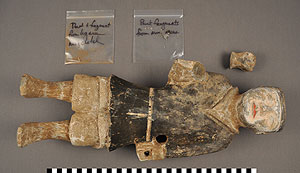Tomb Figurine
2002.03.0001
Detailed Images
Basic Information
| Artifact Identification | Tomb Figurine (2002.03.0001) |
|---|---|
| Classification/ Nomenclature |
|
| Artist/Maker | Unknown |
| Geographic Location | |
| Period | Han Dynasty (206 BC-220 AD) |
| Date | 206 BCE - 221 CE |
| Culture | Chinese |
| Location | Not on Exhibit |
Physical Analysis
| Dimension 1 (Length) | 46.5 cm |
|---|---|
| Dimension 2 (Width) | 18.2 cm |
| Dimension 3 (Depth) | 10.9 cm |
| Weight | 3624 g |
| Measuring Remarks | Under Review |
| Materials | Pigment, Ceramic--Earthenware |
| Manufacturing Processes | Firing, Handbuilding, Painting |
Research Remarks
| Description | This guard or warrior figure may have protected the tomb of a lesser official in the Chinese Emperor’s administration during the Han Dynasty (206 BC-AD 221). It is about 18 inches high and made of painted earthenware. |
|---|---|
| Published Description | Under Review |
| Bibliography | Photo: "21st Century Museum Visitors & Digital Museum Resources", 12/16/2005. |
Artifact History
| Credit Line/Dedication | Richard and Barbara Faletti Family Collection |
|---|---|
| Reproduction | No |
Contact
All information about our collection is constantly reviewed and updated. Please contact Dery Martínez-Bonilla, Registrar, if there is any information you are looking for that isn't currently online.
